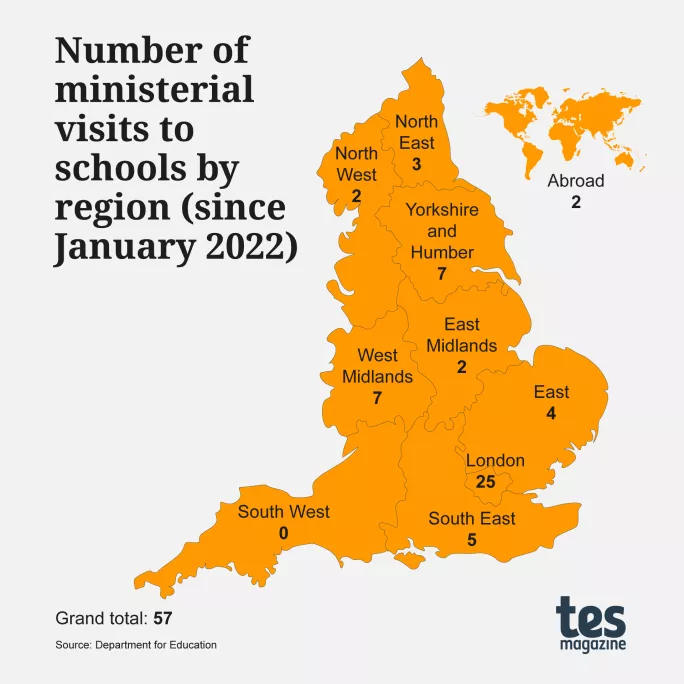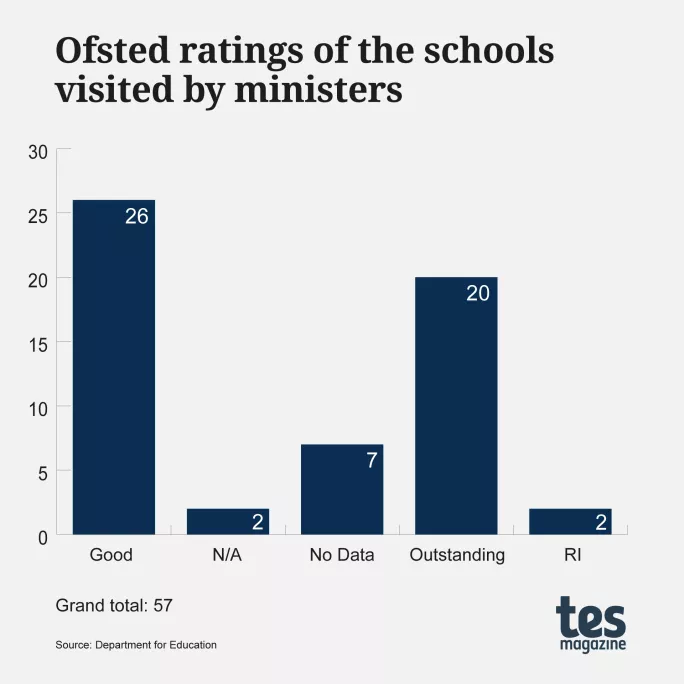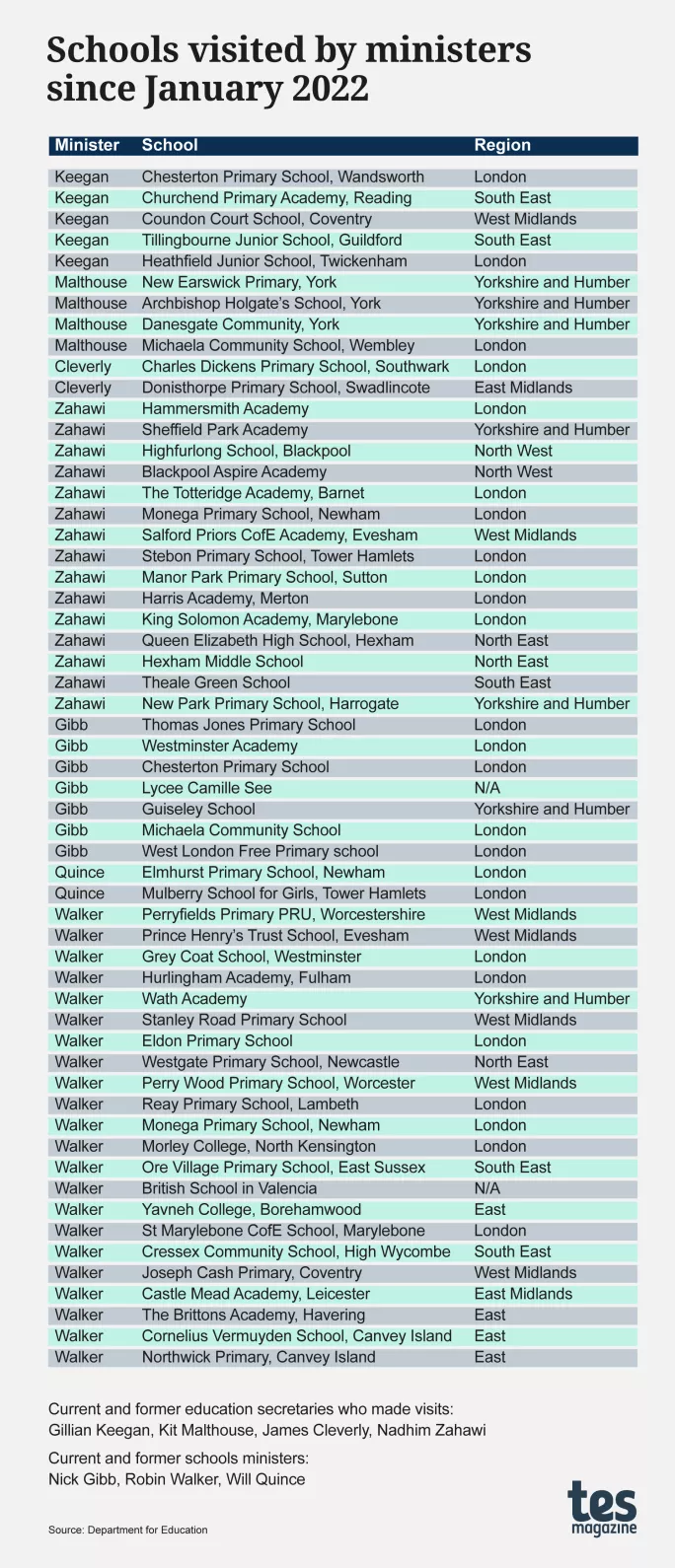Revealed: the schools least visited by ministers

Nearly half of the English schools visited by education ministers since the start of last year were in London, and just two were rated below “good” by Ofsted, Tes can reveal.
The findings have prompted calls for ministers to visit a wider range of schools to see the challenges they face and to “dispel false narratives”.
Since the start of January 2022, there have been 57 school visits by seven current and former ministers (see the full list below). Fifty five of these schools were in England and two were abroad. Of those in England, 25 were within the capital.
Not a single school visit took place in the South West of England during the period covered, and there were just two in the North West and three in the North East.
- Teacher pay: Heads to consider industrial action in response to pay deal
- Dispute: Pay offer “worst possible” outcome for schools
- Gillian Keegan: “I know heads care deeply about pupils”
The visits were carried out by current education secretary Gillian Keegan and her predecessors Kit Malthouse, James Cleverly and Nadhim Zahawi, as well as by schools minister Nick Gibb and his predecessors Will Quince and Robin Walker, who is now chair of the Commons Education Select Committee.

Chris Zarraga, director of Schools North East, said he would encourage ministers to make more visits to the region’s “incredible schools” to “hear first-hand about the challenges they face”.
“This would help dispel the false narrative of a North-South divide in standards in education, and would inform policy to meet the actual needs of schools and their pupils,” he said.
Current government policy “fails to fully appreciate the scale and scope of the challenges North East leaders face, and the quality of education they and their staff deliver”, he added.
Lack of school visits outside London ‘disappointing’
Julie McCulloch, director of policy at the Association of School and College Leaders, said ministerial school visits were important because they allowed politicians to see “the great work that is done by leaders and teachers, as well as the challenges they face”.
“It is disappointing that they have not made more of an effort to visit schools outside London...as this is important in understanding circumstances and pressures which vary between different regions,” she added.
The data also shows that just two of the visits were to schools rated below “good” in their most recent inspection.

Ms McCulloch described this as “especially disappointing”, saying that ministers needed to be able to understand “not only what support is needed but also the detrimental impact that Ofsted judgements in themselves can have”.
Ministers often lavish public praise on to schools they have visited. At the Schools White Paper launch last year, former education secretary Mr Zahawi described a recent visit he had made to Hammersmith Academy in West London, and told how parents “punch the air” when their children get a place there. He repeatedly cited the school as an exemplar during an interview with Tes.
And his successor, Kit Malthouse, defended Michaela Community School in North London following a visit there, while answering questions in Parliament last October.
“Although the head of that school [Katharine Birbalsingh] is obviously very outspoken, she is outspoken because it seems she has a cause,” he said, adding: “It was gratifying at the weekend to see that in the Progress 8 scores she proved that she was right.”
Decisions are partly ‘political’
A former DfE official told Tes that decisions over which schools to visit were based on a range of logistical and political decisions.
“Ministerial visits have to be squeezed in around so many competing pressures,” they said.
For instance, ministers need to stay close to the Commons for votes while the house is sitting during the week, they are usually travelling to and from their constituencies on Mondays and Thursdays and also have a “heavy diary of departmental meetings, which keeps them in their own offices”.
This means that “the time for visits gets squeezed from all sides” and “long travel times to areas like the South West just don’t seem to fit into the packed diaries”, the official added.
As well as the limitations of a full schedule, “the choices are also narrowed by a political motive to boost the profile of a local MP from the same party - that’s why a ‘good’ or ‘outstanding’ school in a ‘friendly’ constituency is often picked,” they said.
The lack of diary time to do a decent range of visits has “been a long-running frustration for those officials tasked with organising ministerial visits”, they added.
Mr Walker, who held the schools portfolio before resigning last summer, has been on 22 school visits since the start of last year, more than any other minister.
Jonathan Gullis, who was schools minister from September to October 2022, did not undertake any visits, according to the data, and neither did Michelle Donelan, though the latter served as education secretary for fewer than 48 hours.
Current education secretary Ms Keegan visited at least five schools in the time period covered, and current schools minister Mr Gibb, seven.
Ms McCulloch said the “revolving door of ministers in recent years” had not been conducive to gaining the insight needed to oversee education policies.
School visits, she said, were important in building ”a greater knowledge of the system over which they preside and a better understanding of the real-world impact of the polices they have responsibility for”.
Last week Tes revealed how the Department for Education’s changing line-up of ministers held more than 130 introductory meetings in the space of just six months.
Academies more commonly visited
The DfE data given to Tes at the end of last month in response to a Freedom of Information request nearly five months earlier, also shows that visits to academies have been much more common than those to local authority-led schools since the start of last year.
Around 40 per cent of schools in England are academies, according to the latest DfE data. But they accounted for more than three-quarters of the 55 ministerial visits to schools in England. In total, 30 visits were to schools in multi-academy trusts, while eight were to single school trusts and four were to free schools.
Maintained schools, meanwhile, accounted for just 10 visits. The remaining visits were to two pupil referral units and a further education college, as well as two overseas schools.
A DfE spokesperson said: ”The vast majority of schools in England are rated either ‘good’ or ‘outstanding’ by Ofsted - 88 per cent as of December 2022, up from 68 per cent in 2010.
“Ministers make every effort to visit a wide range of schools across the country. Since the education secretary took up post in October 2022, 82 per cent of the education settings she’s visited have been outside London, with over half located in the North or the Midlands.”

Register with Tes and you can read two free articles every month plus you'll have access to our range of award-winning newsletters.
topics in this article



